Let us begin with the spelling of the name for it may have caused some confusion. In past posts I have written Eichstaett or Eichstätt, the prior is the English spelling and the latter, naturally, the German. The two dots above the "a" in the German spelling are called an umlaut, and together they are a pronounciation mark that changes the sound of the vowel. The name may appear as a tongue twister but it's really quite simple. The first syllable, "Eich" is pronounced like the name Ike in English. The second syllable, "stätt" requires a little more effort. Think of the word stat, as in the short word for statistic. Then add an "h" between the "s" and the "t." Put the two syllables together and there you have it, "Ike-shtat." Now you're on your on the path to speaking German, that is, a very long and tiresome path.
To review, Eichstätt lies in the federal German state of Bavaria, about half way between München (Munich) and Nürmberg (Nuremberg). Its current popluation is around 13,000 people, but I believe that includes the approximately 4,000 students from the university. Eichstätt is also the seat of government for the Eichstätt Landkreis, roughly the equivalent of a county in America. This county is home to its own Catholic diocese and the Naturpark Altmühltal, Germany's largest Nature Park. However, do not confuse Nature Park with National Park. The difference is that people can not reside within a National Park, but they may in Nature Park, alongside the natural surroundings.
The city boasts a long and detailed history which I will attempt to breifly cover. The first inhabitants came to the region around 10,000 BC. The name "Eichstätt" appeared in the First Millienium BC, and comes from Celtic orgins. From 80 AD - 260 AD the Eichstätt area belonged to Roman Empire. In 741 Saint Boniface, who was Archbishop of Germany at the time, sent Saint Willibald to Eichstätt to christianize the Pagans living in the area, and he created the diocese as its first Bishop. Saint Willibald also guided the construction of the first cathedral in Eichstätt. In 908 the city was officially chartered. In 1634 the Thirty Years War arrived locally, and most of Eichstätt burned to the ground. City leaders began the reconstrucion of Eichstätt and lead architect Jakob Engel guided the rebuilding of the city in an almost entirely baroque style. Today, the well-preserved and dense baroque city center, which sets it apart from most other German towns and cities, remains as one of Eichstätt's claims to fame. The city remained undamaged after World War II, and today is Europe's smallest University city, although I am not too sure of what this designation means.
First we must cover basic orientation. Eichstätt lies in the Altmühl River Valley, which one can see in the photo below. The town is flanked on the West, East, and North by the valley ridge. I took this photo from the eastern ridge, looking Southwest. Being in the nature park, there are many hiking trails on the valley ridges and along the river. Perhaps the most obvious landmark in the phto is the castle in the upper right. That is Willibaldsburg, or Willibald's Castle, but, again, more on that later. Behind Willibaldsburg, on the other side of the ridge, are a few other villages in the valley. Find the bit of freshly tilled earth in the center of the photo, then look at the group of buildings directly behind it. That complex is where my apartment is located. On top of the far ridge you can see an open field centered in the photo. This is an airfield mostly used by gliders. Now move your eyes to the upper left of the photo, that dense cluster of buildings is the old city, and behind that is the campus. I know that's a tad difficult to see so let's zoom in.

In this photo you can see the fall colors on the valley ridge better, but still not the old town too well, so let's keep going.
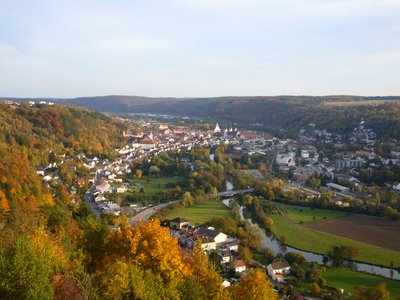
I think this should suffice. The building on the right end, with the two steeples, is the cathedral. Directly left of that stands another tall looking building, the Schutzengelkirche. I believe one can translate this to the Church of the Guardian Angel. A Holy Mass was held here to celebrate the beginning of the semester. The tops of trees which you can see left of that is the campus. On the left hand side of the photo, in the center, you can see what remains of the old city wall at the base of the ridge. Directly right of that is another large looking building, this is the Kloster und Pfarrkirche St. Walburg, or the Cloister and Parish Church of St. Walburg. Funny enough, Saint Walburg was the sister of Saint Willibald.
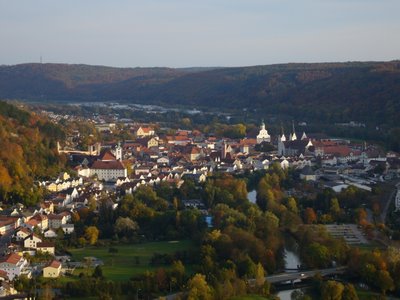
Now I'll take you to the western ridge and you can get a look of the town from the other angle. My bike takes center stage in this photo, with the East looking view in the background. Real men choose pink. Acutally, the shopkeeper only had three used bikes to choose from and this one was in the best working condition. Conisdering that a new bike would have cost around $500 and this was only $80, I was willing to ride in style with this pink and black sportster. The shopkeeper also used the selling point that the color would probably deter thieves.

As you can see the eastern ridge is more heavily developed. I think that may actually be another town, Over Eichstätt.

In this photo we see the village of Rebdorf. It too lies in the Altmühl River Valley, but on the opposite side of the western ridge. A series of greenways and other walking trails lead to Rebdorf along the river and at the base of the ridge. The large building on the left side of the photo is a monastery. To give a better sense of place, if you could enter the photo and look to the right down the ridge you would see Willibaldsburg.
 Here is a closer view of Willibaldsburg from some soccer fields in Rebdorf, but, again, more on the castle a bit farther down the road.
Here is a closer view of Willibaldsburg from some soccer fields in Rebdorf, but, again, more on the castle a bit farther down the road.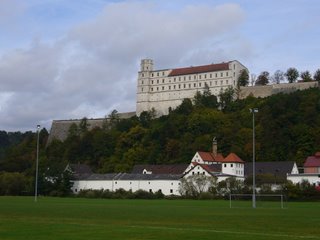
Back in the Eichstätt portion of the valley now, this photo shows the strong presence of agriculture in the area with the plowed filed on the left. I think this is a fairly typical example of the relationship between cities and farms one finds in Germany. True, Eichstätt is no metropolis, but it still exists as an urban area; yet, one finds farm fields right at its edges. They are not industrialized farms either, but local and small scale. This all means that fresher produce can reach the residents of the city quicker and easier, which in turn leads to healthier and cheaper food choices. At the top of the ridge on the right you can also see the brown surface of a rock quarry. Eichstätt is also known for the limestone that comes from the surrounding area. This rock has been used in construction projects around the world and has even revealed quite a few fossils, the third main Eichstätt claim of fame. The view in this photo is also toward my apartment building. You can´t see it here, but let me take you inside.

As I have said in previous posts , my apartment is slightly larger than a typical dorm room. Here is a view of my writing desk. The apartment's a little plain now, but I have some photos on the way to add a little decoration.

Turn around from that view and you find my bed. On the left is my wardrobe. From my understanding most Germans perfer wardrobes to closests in their home.

Take a few steps back and this is the wider view of the room. The glass door leads to my balacony which I share with the apartment next to me.
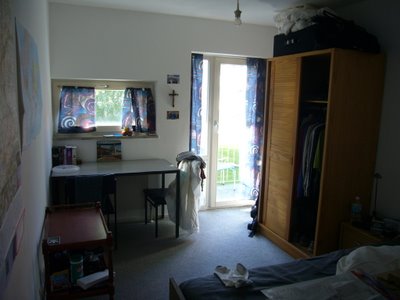
My kitchen space contains the bare minimals, a sink and a stove top. I feel fortunate the leasing agency threw in cabinets and a table.

The grand tour would not be complete without a photo of my crazy German shower. I searched for nearly two weeks trying to find a shower curtain so I wouldn´t have to mop the floor after every shower. I was almost ready to buy window curtains when I got a tip on a store similar to a Home Depot or a Lowe´s on the out skirts of town that sells shower curtains.
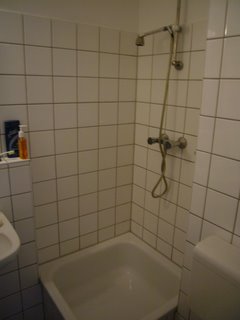 This is the back view of my apartment complex, my building is the farthest on the right. I find the buildings rather ugly from the outside, although the purple I-beams for the balconies add some color.
This is the back view of my apartment complex, my building is the farthest on the right. I find the buildings rather ugly from the outside, although the purple I-beams for the balconies add some color.Not much more inviting from the street side, my building is on the left. On the right is the parking area where we must store our bikes.
The view in this image looks north up the road to the appartment complex on the right, but turn around and you would see my usual grocery store as seen in the second photo below. Keep going in that direction down the main street or take an alley, then take a left at the train station, and you arrive at the city center.

The statue on the right side of the bridge depicts the patron saint of bridges, placed here to protect the bridge travelers obviously.
Below are the north and south views from the bridge, respectively. In the background of the north view one sees the steeple of the Parish Church of St. Walburg.
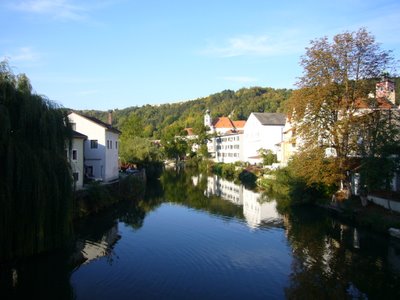
Once across the bridge if you take a right you would come to the Residenzplatz, or the Residence Place. The building on the left side of the photograph is the former residence of the Bishop, today it contains the offices for the Eichstätt Landkreis. A statue of the Virgin Mary rests at the top of the column. It was placed there under the orders of a past Bishop who desired to look out his balcony and she the Blessed Mother under the morning sunlight.
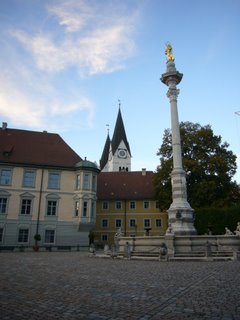
If you take a left once across the bridge instead of a right, you could find your way to the Marktplatz, or the Market Place. A statue of Saint Willibald stands atop a fountain near the center of the photo. Many fine examlpes of the baroque architecture in Eichstätt surround the Marktplatz. Orders during the 1634 reconstruction stated that all buildings had to contain at least a certain number of floors to provide enough living space for residents to return. As an incentive to return, the city leaders proclaimed that new and returning residents to the city would pay no city taxes for life.
Below, a narrow street leads to the Marktplatz at dusk.
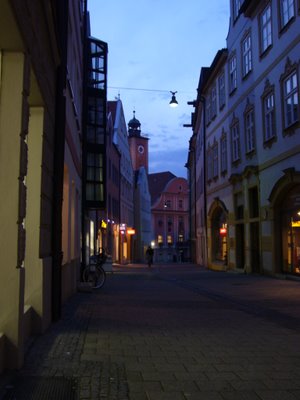
We see another view of the Marktplatz in the following photo. The city hall is the pink building on the left.
The three following photos display the characteristic look of the city center and the streetscape along its narrow winding lanes and network of alleys. It was easy to lose my way during my first days in town, but now I have a fairly good knowledge of the lay of the land.
Head to the east side of the city center and you find Leonardplatz, Leonard Place, as seen below. The building on the left is the Schtuzengelkirche, who´s top was visible in one of the first photographs.
Continue down the street to left and you reach campus. In this view one actually looks back toward Leonardplatz. The large building on the left is the Sommerresidenz, it was originally a summer palace for the Bishop. Today it houses the administration offices of the (warm your tongue up first) Katholische Universität Eichstätt-Ingolstadt. Your on your own with the correct pronounciation for that; however, you might find the English translation better: Catholic University of Eichstaett-Ingolstadt. Simpler still, most staff and students refer to it as the KUE.
If you could turn to the left in the photograph above, you would have the following view of campus. These buildings were of course recent additions in the university´s history.
The universtiy´s orgins go back to a seminary for priests which was founded in 1564. In 1980 Eichstätt´s School of Philosophy and Theology merged with the School of Education to give birth to today´s university. This merger was helped in large part by then Archbishop of München Kardinal Ratzinger, now Pope Benedict XVI, and the former Bishop of Eichstätt.
Despite what the name may lead you to believe, the university is actually both private and public. It retains ties with the Catholic church, but, according to my understanding, is also a member of the Bavarian public university system. The KUE is the only "Catholic" university in the German-speaking world.
Twenty-six years after its founding, the KUE has grown into praise-worthy center of education. The university has eight faculties (think colleges) and five research institutes. The main campus is of course in Eichstätt, but the business college is in Ingolstadt. The school´s enrollment reaches nearly 4,800, with one-fourth of that number as the business students in Ingolstadt. Nearly one-tenth of the students come from abroad, and many of the German students spend time studying abroad themselves. I could be wrong, but I believe a recent report ranked the KUE as the best liberal arts university in Germany.
In the photo below you can see the gardens located behind the Sommerresidenz. Where the Bishop and his dignitaries once stolled, students now spend their time.
Finally, we can explore the castle. Willibaldsburg was built in the 16th century, but for what specific purpose I am not too sure. Today it houses a museum which I have yet to visit, and a courtyard open for all to enjoy. Within the museum are some of the fossil specimens discovered around Eichstätt, including one prized fossil of a complete Archaeopteryx, one of the earliest birds known to exist. I can see the castle from my balcony and my street, it´s hard to miss on its ridge over the valley. At the bottom of the ridge of the first photograph one sees the train zooming along from Eichstätt toward Rebdorf. The second photo was taken along the greenway also leading to Rebdorf.
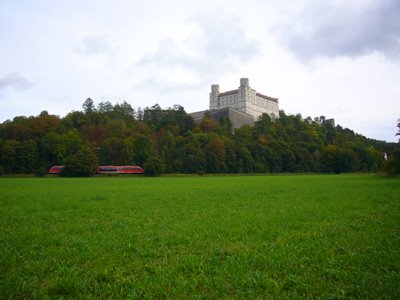
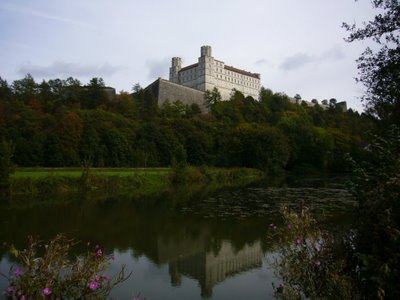
At night, spotlights shine on Willibaldsburg bathing its century old walls in a warm yellow glow.
Eichstätt may not offer the big city life I grew up in, but it none the less feels like home to me now. The town is small enough that I can´t walk anywhere without running into a familar face on the streets. People are friendly, and sympathetic for the mos part towards my imperfect German. As small as it is, I can usually find something to entertain me, whether it´s simply hanging out in with friends in one of the bars or exploring a new hiking trail along the valley. Only one month down, but I already know I will miss Eichstätt when the time comes for me to return home. It´s a good little community, and I recommend you stop by if you´re ever in this neck of the woods.
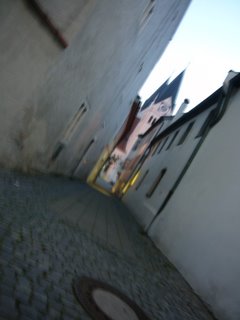
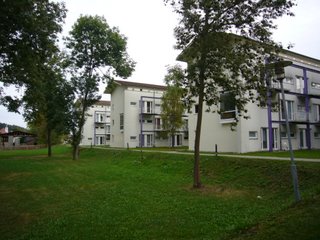

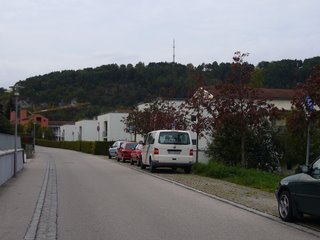
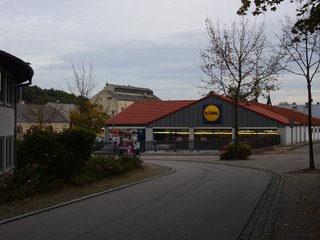
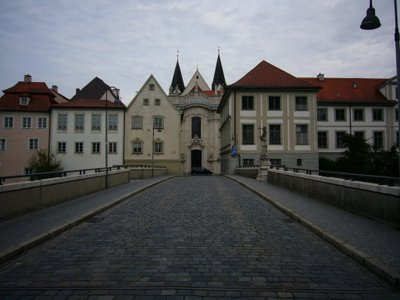


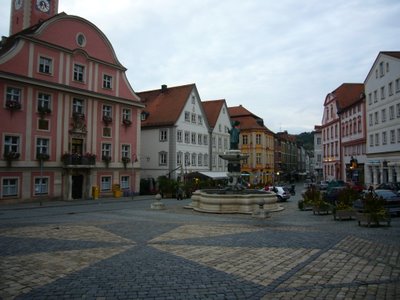

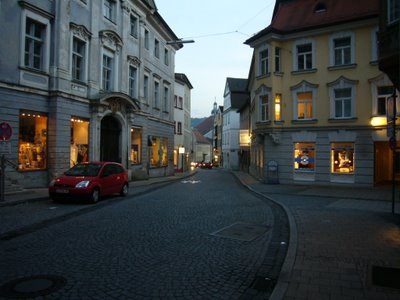
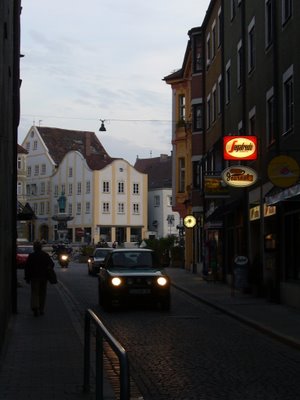
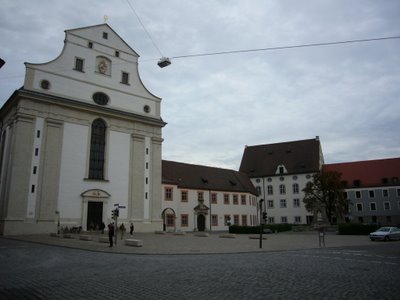




8 comments:
Nicholas,
Every interesting! We didn't see every many people out and about. Is that normal, or did you take these pictures on a Sunday afternoon? Do they have many restaurants to choose from? The Willibaldsburg castle is impressive with the lights at night.
DaddyO
Nicholas,
Are most of the students Catholic at school? And what would you say is the percent of secular vs. non-secular residents in general as compared to that of the states.
I see bishops had it good a few centuries ago. What better way to show your devotion to a god than to live in a 50 room mansion (a vacation mansion at that) while the commoners shack up in little aparments.
Finally, is it just me or does Dad really need to start reading over his posts before he submits them. Just kidding father.
AO
Ok, I guess I need to proof read before I submit. I think faster than I type.
DaddyO
Hey Nicholas, with the change in daylight savings time, are you still 7 hours ahead of us, or just 6 now?
DaddyO
Nicholas, it is good to see your apartment - I have never seen a shower quite like that! What is the view from your balcony?
How many miles are you from Stutgart? (Did I spell that right? If not it is because Dad told me how to spell it.)
I love all your posts and pictures! I wish my room in France were that big and with a stove! Apparently it's a closet? Ah well.
I, of course, love your bike. And the fact that no one would want to steal it but me. hahaha.
So TELL ME, how much has your German improved in just these few weeks?
Anyway, you make me laugh. Miss you!
love, natalie
Dad:
Good point about the lack of people. The photos of the campus were taken before the semester began, so not too many students to be seen. There really are usually many people on the streets, the photos from that day could have been on a Sunday, I don't remember. Sometimes I also prefer to wait until there are no people in the shot to snap the photo. As for the evening during the week it's a different story. Most stores close at six, that's old Germany for you, and people go home. During these nights I like to think that Eichstätt belongs to me because of the desolation on the streets. While returning home from a party at two in the morning last night, I was able to ride my bike in the middle of the streets without ever passing one car. On the weekend nights though more people enliven the streets until the wee hours of the morning.
There are many restaurants to choose from but I haven't found the time to sample many of them. I spent the first month trying to live off of groceries alone to get an idea how much extra money I could afford for luxuries like dinning out, clothes, and rock climbing gear. Most of the other foreign students don't seem too eager to eat in restuarants though. Hopefully I will get to sample some more this month.
As for Willibaldsburg, I have one little note to add due to your comment. Saying "Willibaldsburg Castle" is redundant. Not that I would expect you to know this, but Willibaldsburg translated into English is Willibald's Castle. So to say "Willibaldsburg Castle" is like saying Willibald's Castle Castle.
We changed our clocks at the same time and in the same way as you did.
AO:
Your questions on the religious affliations of the students are tough to answer. Many Germans do not go to church regularly; however, if asked about their faith they would still say there are either Catholic or Protestant. In America we might consider them secular, but here there are still viewed as non-secular. As is America, I see more adults in church than youth. However, I was surprised by the number of students that came to the mass celebrating the beginning of the semester. The church had only standing room remaining and some people didn't receive Communion because the servers ran out of the Eucharist. And as far as Protestant or Catholic, I have met more Catholics than Protestans. However, one can probably explain this due to the dominance of Catholicism is southern Germany.
MC:
In all honesty the view from my balcony is nothing to write home back, hence the reason I didn't. To the left I can look up at a glimpse of the castle. Straight out I see the aparment building across from mine. To the right I can see the train tracks in the foreground, and some rooftops and the valley ridge. I guess this last view doesn't sound that bad, but it's small and obscured by trees and the other apartment buildings.
Stuttgart is probably about 4 hours away by train, but that's only an educated guess. Munich is about 2 and half hours away, and Stuttgart is a bit farther from Eichstätt.
Mycroft Jones:
Considering that all world maps show the same thing, maybe with just a different scale or projection, I imagine it's very possible that our maps are in fact not from the same cartographer. Then again, I would be worried if your world map was drastically different than mine.
Real men choose pink.
Natalie:
Just use your room for sleeping in, and live your life in the town. I'm glad that my bike has another fan, I myself have grown attached to it.
As for my German, I would say that it has definitely improved. I've picked colloquial phrases and words that I never learned in school. At first I would struggle to say something because I couldn't think of how to say the one word that would have made or broken the sentence. So I would give in and speak English. However, I eventually realized that there is almost always another way to say what I would like to say. Now, if I can't think of that key word I simply rethink my sentence and start over, instead of relying on English. Likewise, I had the problem of Germans wanting to speak to me English. At first I would all too easily switch into my mother tongue, even though I knew I should be practicing my German. I am at the point now though that if a German starts speaking to me in English I keep talking in German. Eventually he or she will revert back to German unless they really want to practice their English. I must say that not all is good though. Living and speaking with Germans has taught me that my pronounciation is not as good as I thought it was, but that too is improving. With five weeks down I would say that I feel more confident about my German and with speaking it. You have nothing to worry about.
Everyone:
Thanks for the comments, and keep them coming.
oh Nick, your introduction about Eichstätt was great!!!! I leart a lot of things that I've never heard!!
And It's really interesting how you explain the german's life for your family and friends. I would have had the possibility to have read your blog before studying in Germany!! It would be really helpful!
Thanks!! I keep reading!
Post a Comment